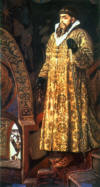Mary
HASTINGS
Born: 1552
Died: AFT 1584
Father: Francis
HASTINGS (2º E. Huntingdon)
Mother: Catherine
POLE (C. Huntingdon)
Daughter of
Francis Hastings, 2º E. Huntingdon, and
Catherine Pole.
Niece of Edward, baron
Loughborough. Her father was a
descendent of the Duke of Buckingham; well her mother was a descendent of the
Duke of Clarence. This made her a cousin to the Kings of England.
When the second
Earl died, he left his oldest son,
Henry, 3rd earl of Huntingdon, the responsibility for supporting
his younger brother and sisters, and arranging their marriages. The dowager
Countess Catherine
assisted in this financially. In 1562 she leased him all her
lands except the manor of Lubbesthorpe, where she lived until her death,
for an annuity of £960 and his promise to double his sisters’ dowries. Henry, the new
Earl, contracted a marriage for
one of his sisters, either Lady Elizabeth or Lady Mary, to
Lord Bobelec,
the Earl of Oxford's heir. The agreement provided for a dowry of 1000
marks and a jointure of £1000.
Edward de Vere was supposed to marry one
of the sisters within a month of his eighteenth birthday. Before that
date, however, Oxford died and the new
Earl became the ward of
William Cecil, Lord Bughley. He married
Burghley's daughter,
Anne Cecil,
instead.
|

Tsar
Ivan of Russia |
Lady Mary, still unmarried and in her late twenties, may have
been a maid of honor at the court of
Queen Elizabeth in 1581 when
Dr. Atkins, an English physician living in Muscovy, suggested her name to
Tsar
Ivan "the Terrible" of Russia in reponse to his interest in beginning
negotiations for an English bride of royal blood. Mary qualified, being a
Plantagenet descendent distantly related to the
Queen. It is uncertain
when she was told of her role in the matter. Ivan was at that time married
to his seventh wife, a woman he planned to discard if the match with an
English "princess" could be arranged. Ivan sent an
ambassador, Theodor Andreevich Pissemsky, to England to negotiate the
marriage and an alliance against the King of Poland. He was to report on
the height, complexion, and measurements of the proposed bride and procure
a portrait of her. Ivan was looking for a stately appearance, and would
also require that Mary and all her attendants convert to the Orthodox religion.
|
Queen Elizabeth, who wanted exclusive English access to the port
of St. Nicholas, deliberately delayed committing herself with the
ambassador, who arrived in England in Sep 1582, at first telling
him that Mary Hastings had recently had smallpox and that a face-to-face
meeting and a portrait would be intrusive. In May 1583, however, she
could put him off no longer. There are two accounts of the meeting, one
from the ambassador himself (translated) and one by Sir Jerome Horsey, who
was not present. They differ widely in some areas but agree that the
meeting was in the Lord Chancellor's garden. The Lord Chancellor was
Sir
Thomas Bromley, but while the Ambassador's account says the garden was at
Bromley's country house, Horsey places it in the gardens at York House,
near Charing Cross in the city of Westminster. According to the Ambassador, he was allowed only an interpreter,
Dr. Roberts, and did not
actually speak to Lady Mary. There was a party of ladies in the garden and
Lady Mary was pointed out to him. She was walking at the head of the
group, between the Countess of Huntingdon (her brother's wife, born
Catherine Dudley) and Lady Bromley (Elizabeth Fortescue). The two groups
circled the garden several times, passing each other, so that the Ambassador
could get a good look. Horsey's version, in which the Ambassador throws himself on the ground before the
Tsar's betrothed and
declares she has the face of an angel, seems unlikely. What the Ambassador
did say was, “It is enough”. He reported to the Tsar that “The
Princess of Hountinski, Mary Hantis is tall, slight, and white-skinned;
she has blue eyes, fair hair, a straight nose, and her fingers are long
and taper”. Some translations make her eyes grey. The long-awaited
portrait was completed in time for him to take it with him when he
returned to Russia. He embarked on 22 Jun 1583 along with England’s
new ambassador to Russia, Sir Jerome
Bowes. Bowes's instructions were to
dissuade the Tsar on grounds of Mary's poor health, scarred complexion,
and reluctance to leave her friends.
Until Ivan's death on 18 Mar 1584,
Mary (at least according to Horsey) had to put up with being called “the
Empress of Muscovia”. Mary herself died, still unwed, before 1589, by
which date a bequest in her will was being contested.




